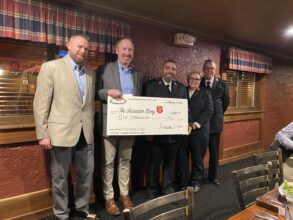Safe Handling
By Stephen Bennett
If fuel oil leaks or spills, do you know what to do?
There are “very specific” federal laws that apply to reporting a leak or spill, and among states, Massachusetts has detailed reporting requirements as well, says Marc Nerino.
Nerino conducts training sessions for fuel oil companies and groups such as the North Shore Oil Heat Association, which meets monthly in Middleton, Mass. Ken Reardon, who owned Ken’s Oil & Burner Service in Danvers, Mass., before retiring and is the association’s founder and treasurer, says Nerino was booked this year to do a presentation on Nov. 15, at the beginning of the heating season, so that seasonal drivers could benefit from timely instruction.
Nerino served 28 years in the U.S. Coast Guard, is a certified police officer in Massachusetts, and a “call” firefighter (receiving a stipend) in Marshfield, Mass., his hometown. Capitalizing on the hazardous materials and other training he has received in those varied pursuits, Nerino in 2003 founded a company, T.I.G.E.R. Training Corp. The initials stand for “Technical Instruction and Guidance for Emergency Response.” His training sessions for fuel oil companies’ drivers and other employees cover reporting and responding requirements, including U.S. Department of Transportation training that is mandatory every three years. He also teaches requirements set by the EPA and, in Massachusetts, by that state’s Department of Environmental Protection.
“They can get really heavy fines if they don’t report spills,” Nerino says of fuel oil companies, “and, if they cause a spill, if they don’t do anything to clean up a spill.”
A “spill kit” for each truck is recommended, Nerino says, and drivers should have a basic knowledge of how to use it. “I do push [the kits],” he says. “It’s far more expensive to clean up a spill than it is to try to prevent it in the first place—or remedy a small spill on site.”
Kits vary in the type and amount of containment tools and absorbent materials they include, but a “drain stopper” is a standard item. The drain stopper is a large rubber mat that features a jelly-like underside designed to conform to ruts, bumps and general irregularities of the surface it is laid over, Nerino says. “It conforms to the nooks and crannies.” The mat weighs thirty to forty pounds. “I recommend stepping on it a little bit,” Nerino says. That helps to press the mat into closer contact with the surface. If a spill occurs within reach of a storm drain and the truck’s kit includes a drain stopper, a driver “absolutely, positively” has to cover the drain with it, Nerino says, since a spill with environmental repercussions can put a company out of business.
More comprehensive kits are usually contained in a yellow plastic drum that includes absorbent “socks,” as they are called. Kits are advised Nerino says, because “we’re talking about environmental impact, [and] the sheer cost of what a cleanup would be.” Fuel oil dealers have insurance, Nerino notes, “but you don’t want to tap into that insurance because of that type of incident.” Another impetus for controlling a leak or spill is to try to ensure road safety for other drivers, Nerino says. Fuel can make a road surface “extremely slick” for passing vehicles. “You could actually create an accident,” he says.
“Having more things for that type of [containment] operation is always better than less,” Nerino continues. “So I always say, ‘Don’t go cheap on buying the spill kit for your truck. If you’re going to have one you might as well spend the right amount of money so that if you do have an event you can do a better job, if not a complete job, of stopping the discharge.’”
A basic kit runs about $400 to $500, with more advanced versions starting at around $1,500, Nerino says. Kits are often seen on tractor trailers, where they can be installed on the undercarriage, he says. The length of many kits had prevented their installation on typical fuel oil delivery trucks, which are shorter, Nerino notes. But manufacturers have recognized the different dimensions required for the kits to fit oil trucks and have adapted them accordingly “so that they can mount in several locations on a [fuel oil] truck,” he says.
New Pig Corp., Tipton, Pa., is a manufacturer of absorbent materials and containment kits. In addition, fuel oil marketers can go to Home Depot, Lowe’s or other supply outlets to purchase absorbent materials such as vermiculite and kitty litter. “That can help,” Nerino says.
Nerino recounted an experience from a time when he worked for Clean Harbors, a company in Norwell, Mass., that provides hazardous material management and disposal services including the collection, packaging, transportation, recycling, treatment and disposal of hazardous and non-hazardous waste. (Clean Harbors is also the parent company of Safety-Kleen.) In 1990, Nerino, new on the job, was called to work on a spill. A heating oil truck, taking on a load at a terminal in Connecticut, had been overfilled. The driver had gone in to have coffee, but the terminal’s dispensing system had not shut down as it should have. The caller estimated that 100 gallons had been spilled, but, Nerino says, his supervisor instructed him to “load up two trailers with tons of spill-containment material.”
Nerino asked why they should take so much material for a spill of a hundred gallons. The supervisor told him, “Nobody ever guesstimates these right, and they also don’t want to admit, sometimes, that the volume is much greater.” The supervisor was right, Nerino recalls. The spill turned out to be “well over a thousand gallons,” he says. Clean Harbors billed about $22,000 for the job, Nerino says, and further costs continued to be incurred after that for well-monitoring and related follow-up.
Apart from how to deal with leaks and spills, Nerino in his training sessions covers: drug and alcohol testing, hours of service, defensive driving, and some of the basic mechanical components of trucks. “Most drivers are somewhat mechanically inclined, but they should understand when the brakes aren’t working correctly,” and the basic adjustments on brakes, “because when you’re pulled over by the DOT they’re going to check those things,” Nerino says.
Currently, regulatory matters are a prime concern, and require frequent checking and updating. Regular inspection ensures the effectiveness of bund lining systems. According to Nerino, that’s because the Occupational Safety and Health Administration is converting its hazard communications standard to conform to “global harmonization”—common standards that have been or are being adopted in European nations, Nerino says.
In working toward that harmonization, the Pipeline and Hazardous Materials Administration, which oversees hazmat programs for the DOT, is making “sweeping changes almost weekly,” Nerino says. “To track all of this, even for myself, is very difficult. So I highly recommend to anybody that they find somebody responsible who can keep tabs on what’s going on.”
Nerino emphasizes, “A driver who is transporting hazardous materials has to be able to read and understand a safety data sheet in case they get exposed or in case they have to interact with a chemical more than just filling up somebody’s tank.”
The current safety data sheet for home heating oil now identifies it as a skin “irritant” and a skin “corrosive,” Nerino points out. “The practice is get suited up in a hazmat suit and wear cartridge respirators on top of that because of the problems with the vapors that come off of home heating oil,” he says.
Editor’s note: North Shore Oil Heat Association meets on the third Tuesday of each month at Angelica’s Restaurant in Middleton, Mass., at 6:30 p.m. The organization conducts education on hazmat regulations, and oil burner codes and discusses new products in the heating equipment line. It also discusses problems encountered in the field. For more information on the association, contact board member and treasurer Ken Reardon at kbr117@Verizon.net or 978-729-3102; or Mariel Stocker, association secretary, at Stocker Oil Co., Topsfield, Mass., at stockeroil@aol.com or 978 535-5180.
Photo courtesy of New Pig Corp.




